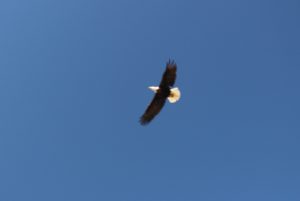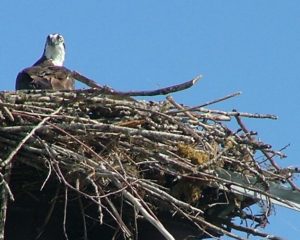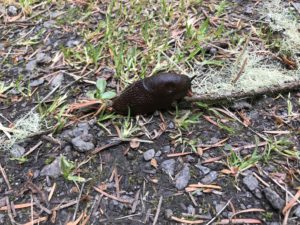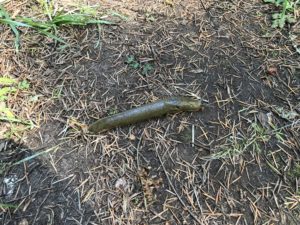Yesterday I wrote about three unusual trees in the Pacific Northwest. I thought today I should tell you a little about some of the wildlife on San Juan Island. There may be some party animals here, but I think they are all at San Juan County Campground or in Friday Harbor. But we do have some pretty cool indigenous wildlife.
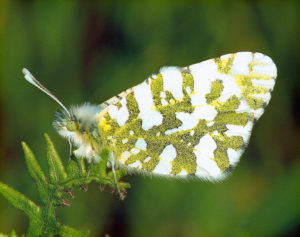 I referred to the Island Marble Butterfly yesterday. This butterfly was thought to be extinct until 1998 when it was found, of all places, at American Camp on San Juan Island. This has been a very exciting discovery and the park is in partnership with a variety of organizations to preserve the species and its habitat: U.S. Fish and Wildlife Service, Washington Department of Fish and Wildlife, Washington Department of Natural Resources, The Xerces Society, KWIAHT (Center for the Historical Ecology of the Salish Sea), San Juan County Land Bank, and the San Juan Preservation Trust. Occasionally our rangers dress up in Island Marble Butterfly costumes to promote awareness of this endangered species.
I referred to the Island Marble Butterfly yesterday. This butterfly was thought to be extinct until 1998 when it was found, of all places, at American Camp on San Juan Island. This has been a very exciting discovery and the park is in partnership with a variety of organizations to preserve the species and its habitat: U.S. Fish and Wildlife Service, Washington Department of Fish and Wildlife, Washington Department of Natural Resources, The Xerces Society, KWIAHT (Center for the Historical Ecology of the Salish Sea), San Juan County Land Bank, and the San Juan Preservation Trust. Occasionally our rangers dress up in Island Marble Butterfly costumes to promote awareness of this endangered species.
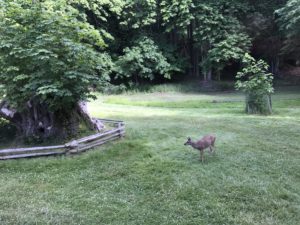 Another less rare indigenous species is the black-tailed deer. By less rare, I mean the deer are taking over the island. No plant is safe from these voracious animals. It is impossible to go a day without seeing some of these deer. They aren’t tame, but they are very comfortable around people. When you take their picture they usually stop and look at you, but don’t let you get too close. We were surprised that you don’t see more deer roadkill but with all the raptors on the island the carcass doesn’t stay around for long.
Another less rare indigenous species is the black-tailed deer. By less rare, I mean the deer are taking over the island. No plant is safe from these voracious animals. It is impossible to go a day without seeing some of these deer. They aren’t tame, but they are very comfortable around people. When you take their picture they usually stop and look at you, but don’t let you get too close. We were surprised that you don’t see more deer roadkill but with all the raptors on the island the carcass doesn’t stay around for long.
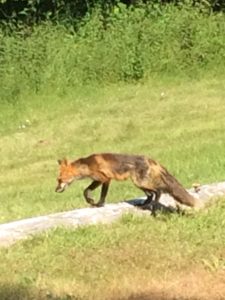 We have a lot of red fox on the island. They are not indigenous, but were brought in to help control the rabbit population. The rabbits are also non-indigenous but there are thousands of them, especially at American Camp where they build extensive warrens. We spent several evenings parked along Picketts Lane watching the rabbits playing on the prairie and the foxes hunting them. The foxes have also learned how to beg from the tourists. We watched two foxes as they worked an overlook. One would sit in front of the parked car and the other would beg at the driver’s side door. We have signs all over asking people not to feed the wildlife – especially the foxes!
We have a lot of red fox on the island. They are not indigenous, but were brought in to help control the rabbit population. The rabbits are also non-indigenous but there are thousands of them, especially at American Camp where they build extensive warrens. We spent several evenings parked along Picketts Lane watching the rabbits playing on the prairie and the foxes hunting them. The foxes have also learned how to beg from the tourists. We watched two foxes as they worked an overlook. One would sit in front of the parked car and the other would beg at the driver’s side door. We have signs all over asking people not to feed the wildlife – especially the foxes!
The foxes and rabbits are not indigenous and the rabbits are destroying acres of prairie habitat, so the National Park Service floated the idea of getting rid of them. The idea faced so much community opprobrium that the idea was abandoned. “You can’t kill the bunnies!” When we took Jackie and John down to watch the foxes hunting the rabbits, we all rooted for the foxes.
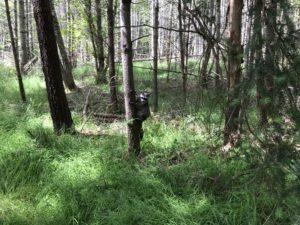 Another common form of wildlife is the raccoons. The raccoons are everywhere and they are the reason we have bear-proof trash containers even though there aren’t any bears on the islands. Tom has spent many mornings cleaning up trash strewed all over the parking lot or parade ground when trash containers are full. The huge Big-Leaf Maple at English Camp holds a raccoon nest and we enjoyed seeing the baby raccoons peeking out. Now that they are scavenging all over, however, they aren’t as much fun.
Another common form of wildlife is the raccoons. The raccoons are everywhere and they are the reason we have bear-proof trash containers even though there aren’t any bears on the islands. Tom has spent many mornings cleaning up trash strewed all over the parking lot or parade ground when trash containers are full. The huge Big-Leaf Maple at English Camp holds a raccoon nest and we enjoyed seeing the baby raccoons peeking out. Now that they are scavenging all over, however, they aren’t as much fun.
The bald eagles are plentiful on the island and we watch them fly over daily. At English Camp we also have an osprey nest and we have watched it all summer as the parents hatched the eggs, taught the babies to fly, and now are teaching them to fish. We recognize their call – especially when Mama is calling to Papa to bring some fish for the babies NOW! I never realized what bullies bald eagles are until I saw they way they harassed the osprey parents, trying to get at the eggs and chicks. We have a telescope spotted on the nest every day, and people love to see one of the osprey in the nest.
Finally, on a smaller scale, we have banana slugs and black slugs. Back in May I had to be careful not to step on them when I was hiking. Now that the weather is drier, the slugs have moved underground. The slugs are an impressive size – some as long as my hand.
That is a sampling of the wildlife on San Juan Island. We are enjoying the variety and the abundance.

